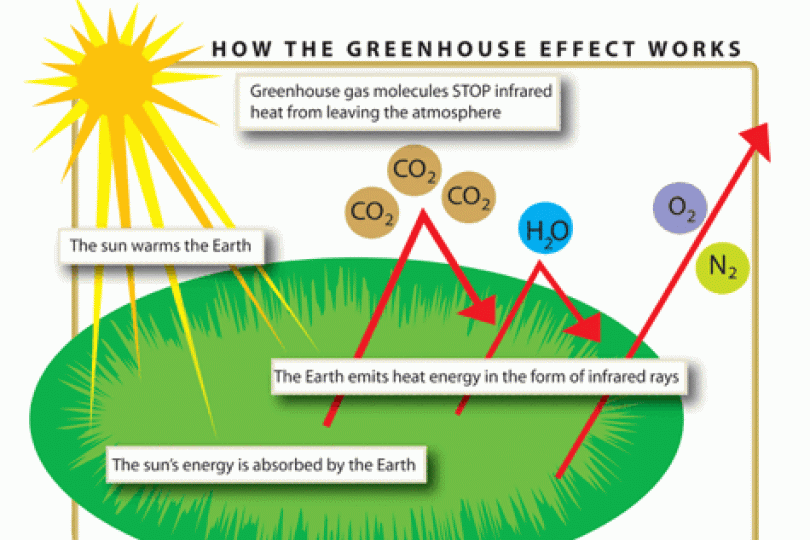THE DISCOVERY OF global warming has its roots in an unlikely source — the search for an explanation of the ice ages.
In the 19th and early 20th centuries, the idea of ice ages was new, and scientists were clamoring for an explanation of how they began. Weather fluctuations are normal, but always within narrow confines. What would cause temperatures to drop so much that ice sheets miles thick would cover vast reaches of the northern hemisphere?
This question led to interesting discoveries. In 1824 Joseph Fourier explained the greenhouse effect, and in 1859 John Tyndall identified several greenhouse gases — most notably carbon dioxide (CO2) and water vapor. Water vapor is the main cause of the greenhouse effect, with CO2 a distant second.
In 1896 Swedish scientist Svante Arrhenius elevated the importance of atmospheric CO2. He pointed out that if the level of CO2 were to rise, the air would be able to hold more water vapor, because warm air holds more than cold air. The higher level of water vapor would then warm the air even more, in a kind of feedback effect.
He also reasoned that the opposite would happen. A decline in CO2 might cause a rapid decline in temperatures. With a crude model of how the global climate system worked, Arrhenius began a laborious series of calculations. He was working with a pencil, not the powerful computers we use today, but Arrhenius determined that cutting the amount of CO2 in the air by half would cool the world maybe five degrees Celsius (eight degrees Fahrenheit).
He also calculated that doubling the amount of CO2 in the atmosphere would raise the Earth’s temperature 5 or 6 degrees Celsius.
His colleague, Arvid Hogbom, who was studying how CO2 cycles through geochemical processes and had been collecting data on industrial CO2 emissions, asked Arrhenius to determine whether these emissions might raise the Earth’s temperature. It was not an idle question. The Industrial Revolution had been in full play for a century, and everywhere factories were burning fossil fuels at rates never seen before, adding significant volumes of CO2 to the atmosphere.
Arrhenius sat down with his model and his pencil, and in due time issued his conclusion: if these emissions continued at their current rate, they could possibly double the amount of CO2 in the atmosphere — in a few thousand years.
The Cost of (Climate) Change
NO MATTER HOW we go about slowing or stopping the rapid warming scientists tell us is imminent, we are going to have to spend a lot of money.
We use a number of different energy sources to generate electrical power — wind, solar, hydro, nuclear, gas, and coal — but we rely primarily on coal. Whether we shift away from coal or find ways to reduce greenhouse gas emissions in gas-fired and coal-fired plants, we will need to make a huge investment.
But the alternative is more expensive — both in terms of money and in human suffering. Sea levels are already rising, making life more difficult for everyone living near sea-level. A sea-level rise of 10 feet will have serious repercussions for all coastal communities. For example, a rise of that level would put the Ingalls shipyard in Pascagoula, Miss. — that state’s largest employer — out of business.
A rise of 20 feet would necessitate the relocation of hundreds of millions of people, many of them in some of the world’s most heavily populated areas, such as the East Coast of the United States, Southern California, and South Florida. Relocating that many people and rebuilding that many buildings, homes, and factories is a challenge unprecedented in the history of the world.
Neither he nor any of his contemporaries saw any reason to worry, but he had confirmed that human activity might affect climate.
His work was ultimately discounted — his climate model had many flaws, and the rate of warming he predicted was grossly overestimated — but the seed of an idea had been planted, and many scientists throughout the coming century would explore the possibility that human activity could generate climate change.
Feedback speeds warming
OVER THE NEXT century, scientists found many influences on climate, none of which seemed to fully explain the ice ages. Occasionally a researcher would find evidence that the planet was warming — and sometimes that greenhouse gases might be causing that warming — but those findings were ignored. Scientists of the time believed that climate could only change very slowly, over periods of several hundreds or (more likely) thousands of years. By then, technology would have found ways to mitigate or adapt to any significant change, whether hotter or colder.
More recent findings suggest climate can — and does — sometimes change as quickly as one century to the next. For example, the North Atlantic was relatively warm from 800 A.D. to 1200 A.D., then began to cool rapidly. About 1250 the Atlantic ice pack began to grow, and by 1300 Northern Europe began experiencing summers so cool that farmers had to learn to grow different crops. During the period 1301-1325, cooler temperatures and persistent rainfall caused widespread famine throughout Europe.
Although this period saw rapid cooling, feedback mechanisms that allow such rapid change can accelerate warming as well. For example, when snow covers the ground, much of the sun’s energy is reflected back into space without being absorbed by the earth, causing further cooling, which brings more snow and ice. Likewise, plant life and dark soil absorb heat, bringing further warming, which keeps snow and ice away.
The reason today’s climate scientists are so interested in receding glaciers and the loss of ice masses at the poles is their role in feedback loops. As this ice disappears, warming becomes more likely, which melts more ice, and so on. If these feedback mechanisms accelerate the trend we are already experiencing, temperatures might rise so rapidly we will not be able to adjust.
Some scientists point to what they call “trigger points,” events that might greatly accelerate warming. Evidence that the permafrost may be thawing kindles this type of concern. Permafrost is frozen soil. Many areas in the extreme northern and southern hemispheres, and at high altitudes, have been frozen for hundreds or thousands of years. Some permafrost, such as vast peat bogs in Siberia, contains large quantities of greenhouse gases — methane and carbon dioxide. If the permafrost melts, those gases will be released, further accelerating global warming — which will thaw more permafrost.
Why blame carbon dioxide?
SUNSPOTS, VOLCANOS, variations in the Earth’s orbit, cosmic rays — all these and more have been suggested as drivers of climate change, but current discussions nearly always focus on greenhouse gases, particularly carbon dioxide (CO2). Why?
The reasons are many. Atmospheric levels of CO2 have been rising steadily since the beginning of the Industrial Revolution, when fossil fuels first came into widespread use. In 1800 the carbon dioxide level of the atmosphere was about 290 parts per million (ppm). By 1958, when Charles Keeling first began collecting samples of the air atop Mount Mauna Loa in Hawaii and in Antarctica, the level had risen to 315 ppm. In 2007, Keeling’s five-year average showed a level of 382 ppm.
The most likely cause of rising CO2 levels is the burning of fossil fuels, which put about six billion metric tons of CO2 into the atmosphere each year. The natural processes that tend to limit atmospheric CO2 levels — plant photosynthesis, absorption by soil and water — remove only about half that amount. They are busy recycling “natural” sources of CO2, such as the air we exhale.
Research shows that higher levels of atmospheric CO2 are associated with warmer periods. One explanation for this association is that rising CO2 levels raise temperature slightly, which allows the atmosphere to hold more water vapor. Water vapor is a more powerful greenhouse agent than CO2, so its presence raises the temperature even more.
Climate scientists do not discount other causes of climate change. The climate system is incredibly complex, and at any time many influences are pushing temperatures up while others are pushing them down.
One difficulty with climate science is that you can’t run experiments in a laboratory. The Earth is the only source of data, and all conclusions regarding climate must come from models, which are tested by the reality of what actually happens.
In the 1980s climate scientists reached a consensus that the atmosphere had warmed significantly in the past century and that industrial processes might be a major reason. Using climate models, a few groups of scientists made projections of what CO2 levels and temperatures would be like in the near future if their premise regarding human-generated CO2 is accurate. They expected those models to tell them whether they were on the right track around the year 2000.
Their expectations were met. Now the consensus of opinion is that greenhouse gases are the most significant cause of the current warming. Most of the discussion in the scientific community now centers on variations within that premise — for example, how fast will the earth warm, what will change as it warms, will new feedbacks bring the temperature back down or make it rise more rapidly.
Because global warming is a global problem, it requires a global solution — that is, a political one. No single nation acting alone will have much effect. Since 1994 the United Nations has been convening conferences on climate change in an effort to bring about the international cooperation necessary to make a difference in this area.
SOURCE: Information in this article comes from many sources, but an excellent summary of climate research through the 20th century can be found in The Discovery of Global Warming, by Spencer R. Weart (Harvard University Press: 2003).






